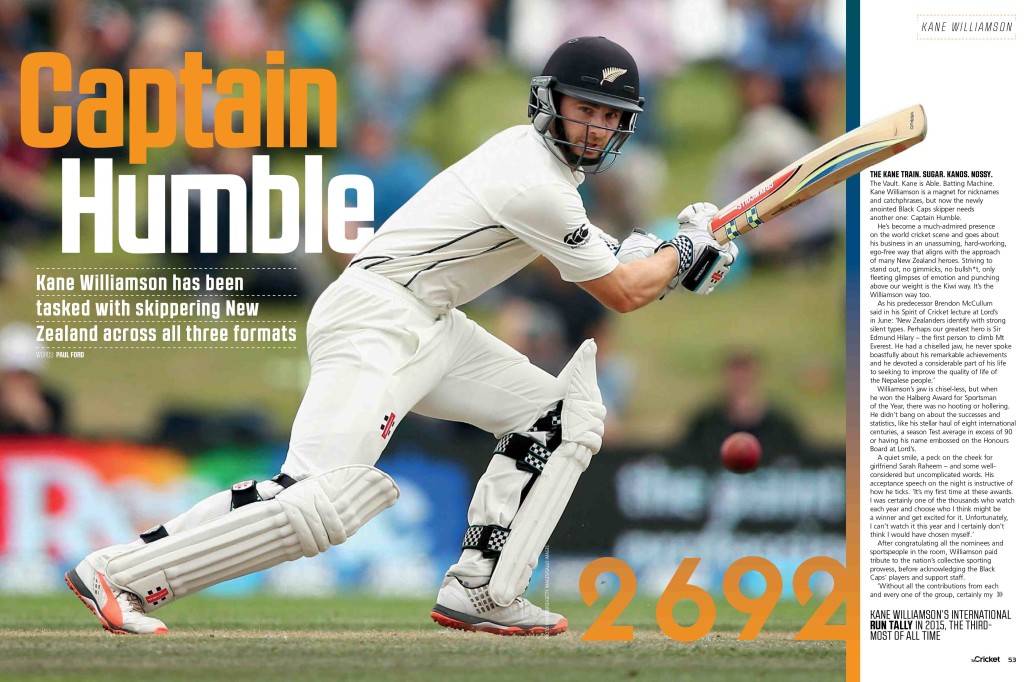Kane Williamson became the youngest to score a century against every Test nation on Sunday. We featured him in the latest edition of SA Cricket magazine.
The Kane Train. Sugar. Kanos. Nossy. The Vault. Kane is Able. Batting Machine. Kane Williamson is a magnet for nicknames and catchphrases, but now the newly anointed Black Caps skipper needs another one: Captain Humble.
He’s become a much-admired presence on the world cricket scene, and goes about his business in an unassuming, hard-working, ego-free way that aligns with the approach of many New Zealand heroes. Striving to stand out, no gimmicks, no bullsh*t, only fleeting glimpses of emotion, and punching above our weight is the Kiwi way. It’s the Williamson way too.
As his predecessor Brendon McCullum said in his Spirit of Cricket lecture at Lord’s in June: ‘New Zealanders identify with strong silent types. Perhaps our greatest hero is Sir Edmund Hilary – the first person to climb Mt Everest. He had a chiselled jaw – he never spoke boastfully about his remarkable achievements and he devoted a considerable part of his life seeking to improve the quality of life of the Nepalese people.’
His jaw is chisel-less, but when Williamson won the Halberg Award for Sportsman of the Year, there was no hooting or hollering. He didn’t bang on about the successes and statistics like his stellar haul of eight international centuries, a season Test average in excess of 90 or having his name embossed on the Honours Board at Lord’s.
A quiet smile, a peck on the cheek for girlfriend Sarah Raheem – and some well-considered but uncomplicated words. His acceptance speech on the night is instructive of how he ticks. ‘It’s my first time at these awards. I was certainly one of the thousands who watch each year and choose who I think might be a winner and get excited for it. Unfortunately, I can’t watch it this year and I certainly don’t think I would have chosen myself.’
After congratulating all the nominees and sportspeople in the room, Williamson paid tribute to the nation’s collective sporting prowess, before acknowledging the Black Caps’ players and support staff. ‘Without all the contributions from each and every one of the group, certainly my contribution wouldn’t mean very much. So thank you very much.’
It was the spoken word version of Williamson’s familiar low-key batting celebrations: batting helmet in one hand, a modestly raised bat in the other, head bowed, a handshake, then refocus and on with the job.
Captain Humble’s tenure is in its infancy but we know what to expect: an evolution of McCullum’s leadership, but stamped with Williamson’s focus on the team, being a proud New Zealander, working bloody hard and not getting carried away about anything ever.
Williamson is the real thing – a prodigy who has delivered on the promise and talent he showed as a young player in Tauranga, a summer hotspot on the east coast of the North Island. He is still only young, turning 26 during the second Test match of New Zealand’s upcoming Zimbabwe tour.
He is one of five siblings, with a twin brother and three older sisters. Sport was unavoidable at Willamson HQ: his father was a decent cricketer and hockey player, his mother played representative basketball, and volleyball was also in the family. Williamson played rugby, volleyball, football and basketball (in nappies and beyond). Cricket seeped into his veins early too – he reckons he was two when he first got his hands on a bat. Doug Bracewell was a childhood mate, and Trent Boult lived down the road.
The kid called Kane was on the lips of local cricket aficionados from his primary school days, when his dad helped get an artificial pitch installed on the school field adjacent to his home. He made his first-class debut for Northern Districts at Eden Park Outer Oval aged 17 and still at Tauranga Boys’ College. Apparently he used Graeme Thorpe’s old Kookaburra test bat at one part of his early career, given to him by former Canterbury player Bill Aldridge.
Humility was an early trait too – one former coach Josh Syms, told the Bay of Plenty Times last year: ‘He had a thirst to be phenomenal – but not at anyone else’s expense.’ Aged 12, he famously rescued his team with an unbeaten century off the penultimate ball of the match, nine down, and waited on the boundary to applaud his batting partner who was unbeaten on three.
Away from the game, his airport luggage provides clues to other interests – he is often accompanied by a guitar case. Mark Nicholas tells a story about inviting Williamson to bat with Sachin Tendulkar in a charity match in the UK, but it clashed with Glastonbury. Music in the mud won that day. He is probably decent but we’re unlikely to ever spot him plucking strings or singing duets with Shane Watson or Dwayne Bravo or AB de Villiers’ wife anytime soon.
Most recently his dress sense and acting efforts have come under scrutiny, a side-effect of the media machine accompanying an IPL stint with the Sunrisers Hyderabad. Photos emerged from a very floral fashion shoot for designer Tommy Hilfiger, provoking much mirth among Kiwi cricket fans.
On the acting front, Williamson turned in a performance so wooden Keanu Reeves would have been proud in an ad for team sponsor and courier company DTDC India. He can expect to hear his clunky closing line: ‘Guys, where’s coach?’ repeated ad nauseum from the embankments of South Africa and beyond.
As a batsman, Williamson is an absolute treat to watch. South African cricket fans are in for something special if (but surely when) the Kiwi captain gets going. He bats in a precise way, relying on technique, timing, courage, judgment. He looks good even when nonchalantly knocking a wide one ‘on the head’, invariably piercing the cordon, down to the third man fence for four more.
His motivation is not mathematics, despite having an array of great numbers in his wake: like being NZ’s youngest Test century debutant (131 against India at Ahmedabad aged 20), and the youngest New Zealand batsman to 3000 Test runs (aged 24 years and 151 days), and joining Don Bradman, Neil Harvey, Garry Sobers, Sachin Tendulkar and Graeme Smith in scoring ten Test centuries before turning 25.
The former coach of Northern Districts, Williamson’s first-class home team, Grant ‘Beagle’ Bradburn put it thus: ‘I’ve never known Kane to get fixated with numbers or milestones. A player like Kane is always looking for quality movements, and quality shapes. He knows they are the recipe to scoring runs. The runs will just be a by-product of moving well, and having good shape, because he’s got so much trust in his ability that runs will just come.’
But trust in that ability does not come from DNA alone. Williamson is renowned as a player who trains the house down; he just loves to bat. Not for the hell of it, but to refine his movements, refine his shapes, address technical deficiencies and ensure everything is as it should be.
When Martin Crowe, whose feats Williamson is set to emulate and eclipse, laid out advice in a Cricinfo column in 2012 you could imagine the young batsman poring over it and considering whether the unsolicited public counsel warranted his consideration. ‘Better if you put the bat on the ground and tap it softly, like you did when you made 40 hundreds at school…’
His batting is not only silky and well-drilled, it is also intransigent. He is magnificently difficult to dismiss, with an impeccable defensive repertoire. Former Australian captain Allan Border noticed last year: ‘Of all the gun batsmen going around, Williamson would be the one I’d choose to bat for my life. Over AB de Villiers, in front of Steve Smith, in front of Warner, in front of all of them.’
His technique is adaptable too. By the time Williamson arrives on South Africa’s shores, he is likely to become the first New Zealand batsman to complete a ‘full house’ of Test centuries against every major Test playing nation. Zimbabwe, NZ’s stopover on the way to South Africa, is the only one missing from his CV at present.
The South African series looms as a huge challenge for New Zealand, especially as it is Test matches only, so provides no opportunity for the Black Caps to flex their impressive limited-overs muscles.
Three years ago New Zealand were destroyed in a 45-all-out Cape Town annihilation that was arguably the darkest day in our cricketing history – and by ‘day’ that would be 116 balls and 100 minutes.
That apocalypse also led to a catharsis, as then-greenhorn captain Brendon McCullum realised things needed to change. He spoke about the fact New Zealand fans can cope with their national XI losing, but they could never embrace a team of ‘overpaid, under-delivering, lazy prima donnas’.
Now, in 2016, the panelbeating and makeover is complete but McCullum has hung up his black cap, and we get to benchmark how far the Black Caps have developed since the doomsday. It will be impossible not to compare how the WillIamson-led XI fares against a South African team that will be expecting – and expected – to win at home.
Williamson’s calmness, nous and obviously runs will be crucial to New Zealand being competitive in the series. His best one-day batting and bowling efforts have come against the Proteas (and he’s been surfing with Dale Steyn recently too) so they hold no fears on that front.
But there is a different pressure now: leadership. The captaincy armband is a new one for him in Test cricket – he will have worn it only twice before the South African series. The Black Caps chances of success rely heavily on him managing the juggling act of captaincy and century-making. If anybody can, Captain Humble can.
Written by Paul Ford, a New-Zealand-based freelance cricket writer.







